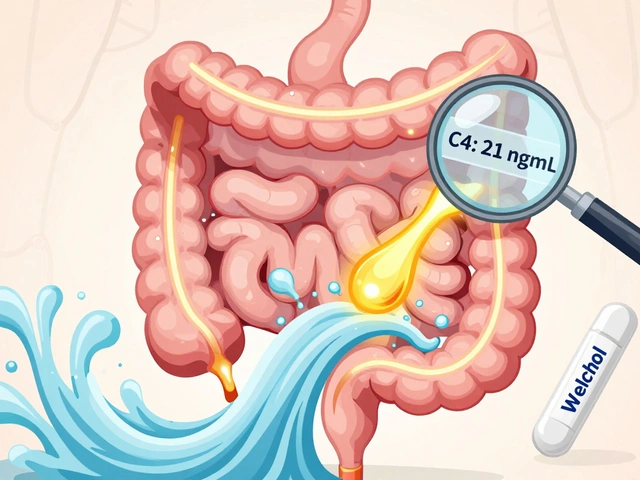
Doxycycline Dosage Calculator
How to Use This Tool
This calculator helps determine appropriate doxycycline dosage for sinus infections based on age, weight, and medical factors. Important: Doxycycline only works for bacterial sinus infections, not viral ones.
Dosage Recommendation
Please enter your information to see dosage recommendations.
Important Safety Information
Quick Summary
- Doxycycline is an oral tetracycline antibiotic often used when first‑line drugs fail or aren’t suitable.
- It works best on bacterial sinusitis; it won’t help a viral infection.
- Typical adult dose is 100mg twice daily for 7‑10days, but doctors may adjust based on severity and patient factors.
- Common side effects include nausea, sun sensitivity, and mild yeast infections; serious risks involve liver problems and rare allergic reactions.
- Pregnant or nursing women, children under 8, and people with certain heart conditions should avoid doxycycline unless absolutely necessary.
What is doxycycline?
Doxycycline is a broad‑spectrum tetracycline antibiotic that blocks bacterial protein production, stopping the bugs from growing. It’s been on the market since the 1960s and is available as tablets, capsules, and a liquid suspension. Because it reaches good levels in nasal tissue, doctors sometimes pick it for stubborn sinus infections.
How does doxycycline work against sinus infections?
Sinus infections, or sinusitis, can be bacterial or viral. In bacterial sinusitis a condition where bacteria multiply in the sinus cavities, causing thick mucus, pain, and fever, doxycycline targets the bacteria’s ribosome, halting protein synthesis. This stops the infection from spreading and gives the immune system a chance to clear the rest.
When the infection is viral, antibiotics like doxycycline do nothing. That’s why doctors first look for signs that a bacterial cause is likely-symptoms lasting more than 10 days, high fever, or worsening after an initial improvement.
When is doxycycline prescribed for sinus infections?
Guidelines from the Infectious Diseases Society of America (IDSA) recommend doxycycline mainly in two scenarios:
- Patient is allergic to first‑line drugs such as amoxicillin or has a known antibiotic resistancethe ability of bacteria to survive despite antibiotic exposure to those drugs.
- Patient has comorbidities (e.g., COPD, asthma) that increase the risk of atypical bacteria like Mycoplasma pneumoniae or Chlamydophila pneumoniae, which doxycycline covers.
It’s not a first‑line choice for uncomplicated acute bacterial sinusitis in most healthy adults, but it’s a solid backup.

Dosage and treatment course
Doctors usually start adults on 100mg of doxycycline twice daily. Children over 8years may receive the same dose based on weight. The course lasts 7‑10days, but the exact length depends on symptom resolution and any underlying health issues.
| Age / Weight | Dosage | Frequency | Typical Duration |
|---|---|---|---|
| Adults (≥18yr) | 100mg | Twice daily | 7‑10days |
| Children 8‑12yr (≥30kg) | 2mg/kg (≈100mg) | Twice daily | 7‑10days |
| Children <8yr | - | - | Not recommended |
Comparing doxycycline with other common sinus infection antibiotics
Below is a quick side‑by‑side look at doxycycline versus the most frequently prescribed alternative, amoxicillin.
| Feature | Doxycycline | Amoxicillin |
|---|---|---|
| Class | Tetracycline | Penicillin |
| Typical adult dose | 100mg BID | 500mg TID |
| Coverage of atypical bacteria | Good | Poor |
| Common side effects | GI upset, photosensitivity, yeast infection | Diarrhea, rash |
| Contraindications | Pregnancy, children <8yr, severe liver disease | Penicillin allergy, renal impairment |
Possible side effects and safety concerns
Every medicine has a risk profile. With doxycycline, the most frequently reported side effectan unwanted physical reaction after taking a drug is mild stomach upset. Others include:
- Increased sensitivity to sunlight - stay out of direct sun for a few weeks after finishing the course.
- Yeast infections, especially in women, due to disruption of normal flora.
- Rare but serious: liver inflammation, severe allergic reactions, or blood‑cell problems.
Special populations need extra caution:
- Pregnancythe condition of carrying a developing embryo or fetus - doxycycline is classified as pregnancy‑categoryD in the U.S.; it can affect fetal bone growth and teeth coloration.
- Breast‑feeding - small amounts pass into milk; best to avoid unless the benefit outweighs the risk.
- People with severe liver disease - the drug is metabolized by the liver, so impaired function can raise blood levels.

How to take doxycycline correctly
Follow these tips to maximise effectiveness and cut down side effects:
- Take the pill with a full glass of water; staying upright for at least 30minutes helps prevent throat irritation.
- Consume it with food if you experience nausea, but avoid dairy or calcium‑rich foods within two hours, as they can reduce absorption.
- Finish the entire prescription, even if you feel better after a few days.
- Use sunscreen or wear protective clothing, especially during long outdoor periods.
- Notify your doctor if you develop a rash, persistent stomach pain, or yellowing of the eyes.
Frequently Asked Questions
Can doxycycline cure a sinus infection that’s been there for weeks?
If the infection is bacterial and the bacteria are still sensitive to doxycycline, a full 7‑10‑day course can clear it. Persistent symptoms after treatment may mean the bug is resistant, the infection is viral, or there’s an underlying blockage that needs a different approach.
Is it safe to use doxycycline together with ibuprofen?
Generally yes. Ibuprofen doesn’t interfere with doxycycline’s action. Just keep an eye on stomach upset-both meds can irritate the lining.
What should I do if I miss a dose?
Take the missed tablet as soon as you remember, unless it’s almost time for the next dose. In that case, skip the missed one and continue on schedule. Don’t double‑up.
Can I take doxycycline if I’m allergic to penicillin?
Yes. Doxycycline belongs to a different drug class, so a penicillin allergy isn’t a problem. However, tell your doctor about any other drug allergies you have.
Is doxycycline effective against viral sinusitis?
No. Antibiotics target bacteria, not viruses. Using doxycycline for a viral infection won’t help and can increase resistance.
Next steps - when to see a doctor
If you’ve taken the full prescription and still have severe facial pain, swelling, a fever over 38.5°C, or thick green mucus, it’s time to get re‑evaluated. You may need a different antibiotic, imaging studies, or even a referral to an ENT specialist.
Remember, antibiotics are powerful tools-but only when used the right way. Knowing when doxycycline is appropriate, how to take it, and what to watch for can turn a frustrating sinus infection into a swift recovery.






6 Comments
Doxycycline can be a useful backup for bacterial sinusitis when first‑line agents aren’t suitable, but it’s important to follow the prescribed course and avoid sun exposure.
The article erroneously suggests that doxycycline “reaches good levels in nasal tissue”; a more accurate statement would be that it achieves therapeutic concentrations in sinus mucosa, not merely “nasal tissue,” and the dosage recommendations should be expressed in milligrams per kilogram for pediatric patients rather than a vague approximation.
when we think about antibiotics they become more than a pill they are a bridge between the body and unseen world of microbes we must respect them but also remember they are not magic cures.
In many parts of the world, sinus infections are first treated with steam inhalation and herbal teas, but clinicians still rely on evidence‑based antibiotics like doxycycline when bacterial involvement is confirmed; bridging traditional practices with modern medicine can improve adherence and outcomes.
While cultural home remedies have their place, dismissing doxycycline in favor of folklore can prolong illness and promote resistance; patients should heed the clinical guidelines rather than anecdotal cures.
From a mechanistic standpoint, doxycycline operates by binding to the 30S ribosomal subunit, thereby inhibiting the translocation step of protein synthesis; this pharmacodynamic profile, coupled with its favorable tissue penetration, justifies its utilization in atypical bacterial sinusitis, especially when macrolide resistance is prevalent in the community.